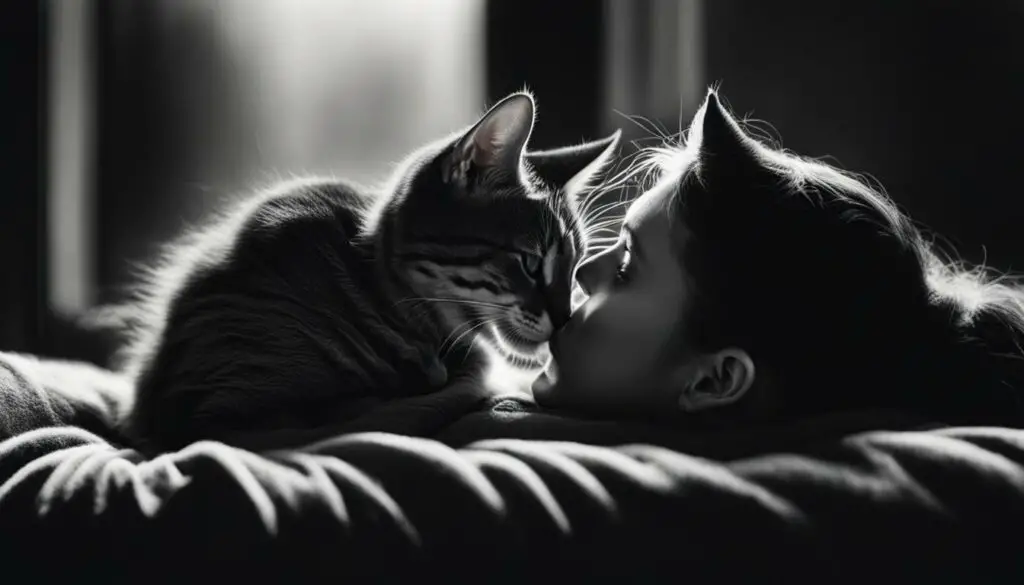I’ve often wondered why my cat, like many others, has a strange habit of biting my nose while I’m peacefully asleep. This peculiar behavior may leave you perplexed, but fear not, for I have delved into the world of cat behavior to decode their motivations. Understanding why cats bite during sleep can help us respond appropriately and strengthen our bond with these enigmatic creatures.
When it comes to cat behavior, there are several reasons why they may engage in this biting behavior during sleep. It can be a form of communication, play, overstimulation, fear, or even territorial behavior. Let’s explore each of these motivations to better understand our feline friends.
Key Takeaways:
- Cats may bite their owners’ noses during sleep as a form of communication, trying to convey their needs or desires.
- Some cats may bite playfully during sleep, treating it as interactive playtime.
- Overstimulation during petting sessions can lead to biting as a way for cats to communicate that they’ve had enough.
- Biting during sleep can also be a result of fear or stress, triggered by changes in the environment.
- Cats biting their owners’ noses may be a display of territorial behavior, asserting dominance and marking their territory.
Cat Biting as Communication
When cats bite their owners’ noses during sleep, it may seem like an aggressive act, but it’s often a form of communication. Cats use biting as a way to get their owners’ attention and convey a message. It’s important to understand that this behavior is not driven by anger or spite, but rather a way for cats to express their needs or desires.
By biting, cats are trying to communicate something to their owners. It could be that they want to be fed, let outside, or simply want some playtime. It’s essential for cat owners to pay attention to their cat’s body language and understand the context in which the biting occurs. By doing so, owners can respond appropriately and strengthen their bond with their furry friends.
It’s worth noting that biting is just one way that cats communicate, and it’s important to observe other aspects of their behavior as well. Cat body language, such as ear position, tail movement, and overall posture, can provide valuable insights into a cat’s mood and intentions. By understanding their unique communication methods, we can better understand and respond to our feline companions.
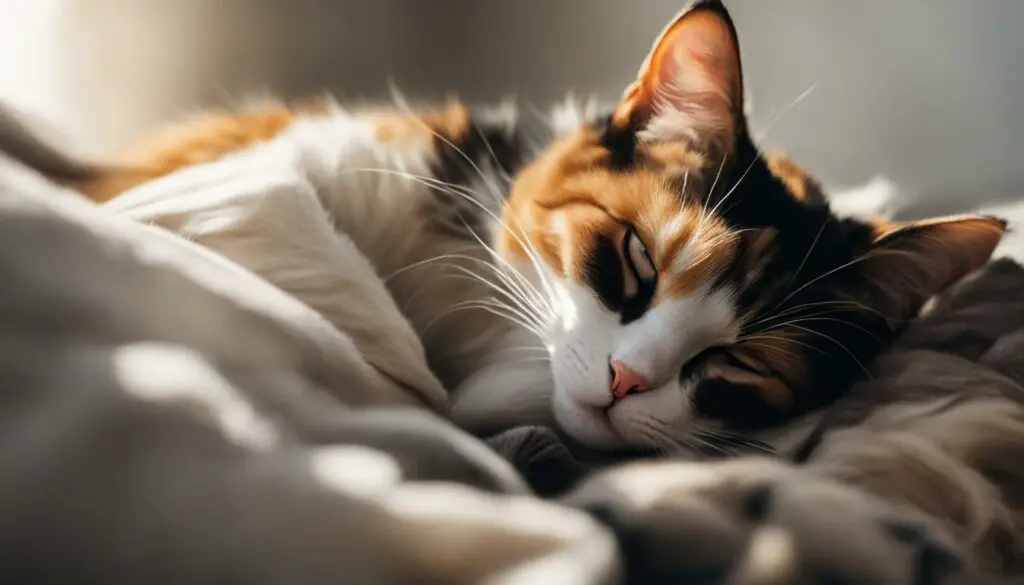
Understanding Cat Body Language
Cat body language is an essential aspect of decoding their behavior and understanding their needs. Cats use a variety of cues to express their emotions and intentions. For example, a cat with relaxed ears and a gently swaying tail is likely feeling calm and content, while a cat with flattened ears and a puffed-up tail may be feeling frightened or defensive.
When it comes to biting, it’s crucial to pay attention to the context in which it occurs and the accompanying body language. If a cat appears tense, with dilated pupils and a stiff posture, the biting may be a sign of fear or stress. On the other hand, if a cat playfully nips during a game, it’s likely part of their natural hunting instincts.
By familiarizing ourselves with cat body language and paying close attention to their cues, we can better understand their intentions and create a harmonious environment for both cats and their owners.
Cat Biting as Playful Behavior
One reason why cats may bite their owners’ noses during sleep is as a form of playful behavior. Just as cats engage in biting during playtime while awake, they may continue this behavior while their owners are asleep. This biting is usually not aggressive but rather a way for cats to initiate interactive play and engage with their owners. It is their way of expressing their desire for interaction and may be accompanied by other playful behaviors such as pouncing or batting with their paws.
Play biting during sleep is often motivated by the cat’s natural instincts to hunt and practice their predatory skills. By biting their owner’s nose, cats are essentially treating it as a target or toy. While this behavior may startle or even slightly hurt the owner, it is important to understand that it is not meant to cause harm but rather to engage in playful interaction.
To discourage excessive play biting during sleep, it is recommended to provide cats with alternative outlets for their playful energy, such as interactive toys or scratching posts. Additionally, spending time playing with your cat before bedtime can help tire them out and reduce the likelihood of them engaging in playful biting during sleep. It is also essential to reinforce positive behaviors by rewarding your cat when they engage in appropriate play and redirecting their attention when they start to bite too aggressively.
| Causes of Biting | Explanation |
|---|---|
| Playful behavior | Cats may bite during sleep as a form of playful interaction. |
| Instinctual hunting behavior | By biting, cats may be practicing their predatory skills. |
| Desire for interaction | Biting serves as a way for cats to engage with their owners during sleep. |
“Play biting during sleep is often motivated by the cat’s natural instincts to hunt and practice their predatory skills.”
Understanding and Managing Play Biting during Sleep
To better understand and manage play biting during sleep, it is important to observe your cat’s body language. Cats may exhibit signs of excitement or playfulness before initiating a bite, such as dilated pupils, pouncing movements, or a swishing tail. Recognizing these cues can help you anticipate and redirect their behavior before they bite. It is also crucial to avoid reacting with anger or punishment, as this can confuse or frighten your cat.
Creating a consistent routine for playtime, providing mental stimulation with puzzle toys, and engaging in interactive play sessions can help channel your cat’s energy and reduce their inclination to play bite during sleep. Additionally, providing them with designated scratching posts and toys can help satisfy their natural hunting instincts and redirect their attention away from biting.
By understanding the underlying motivations for play biting during sleep and taking proactive steps to manage the behavior, cat owners can ensure a harmonious and enjoyable relationship with their feline companions.
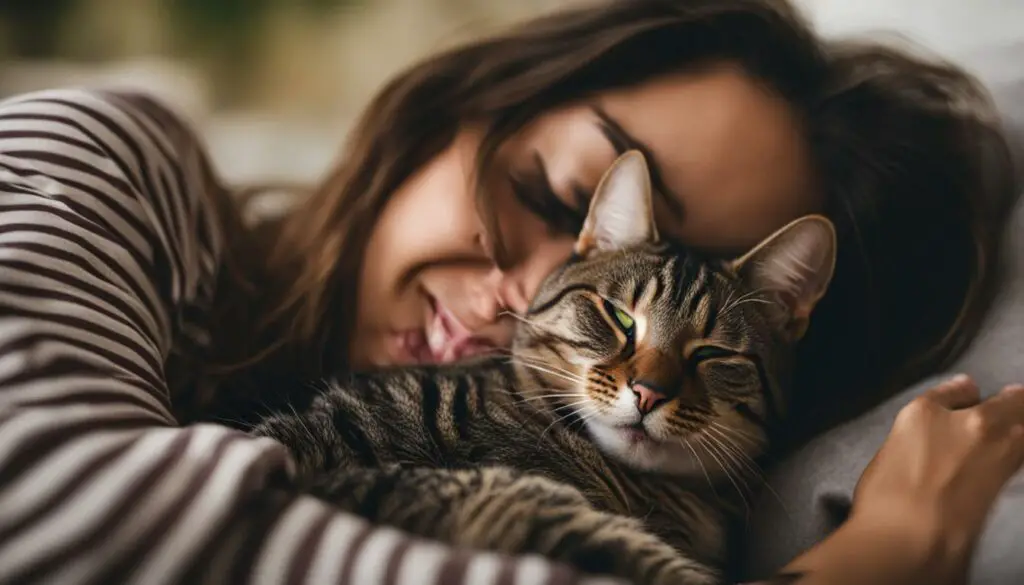
Overstimulation and Biting
Cats can sometimes become overstimulated during petting sessions, leading to biting as a way to communicate that they have had enough. It’s important to understand that this behavior, known as petting aggression, is not a sign of aggression or anger towards the owner. Instead, it is an instinctual response when a cat feels overwhelmed or overstimulated.
When a cat becomes overstimulated, their threshold for touch and stimulation decreases. Signs of overstimulation can include twitching tails, dilated pupils, flattened ears, and increased agitation. If these signs are ignored and petting continues, the cat may resort to biting as a way to protect themselves.
To prevent overstimulation and biting, it’s crucial to pay attention to your cat’s body language during petting sessions. Watch for any signs of discomfort or agitation and be sensitive to their individual preferences. If you notice your cat starting to show signs of overstimulation, slowly and gently remove your hand and give them space to calm down.
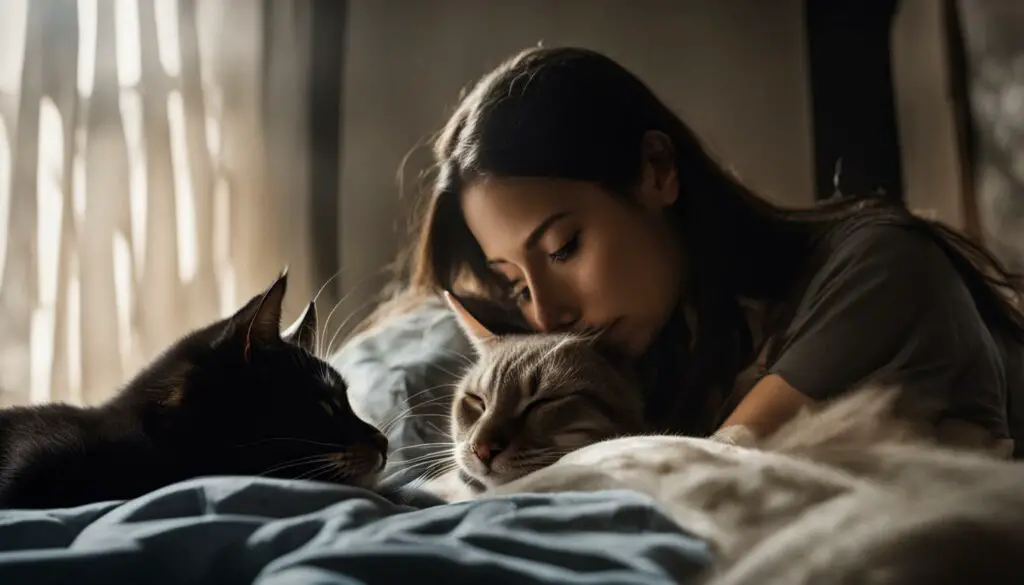
In addition to being aware of your cat’s body language, providing interactive toys during playtime can help redirect their energy and prevent biting. By engaging your cat in play, you are providing them with an outlet for their natural predatory instincts while also providing mental and physical stimulation.
Remember, every cat is unique, and what may be overstimulating for one cat may not be for another. By observing and respecting your cat’s boundaries, you can help create a safe and enjoyable environment for both you and your feline companion.
Fear and Stress-Related Biting
When it comes to cats biting their owners’ noses during sleep, fear and stress can be significant factors. Cats are sensitive creatures, and changes in their environment or routine can trigger feelings of fear and stress. These emotions can manifest as defensive behaviors, such as biting, as cats try to protect themselves.
It is important for cat owners to recognize and address the source of their cat’s fear or stress in order to reduce biting incidents. Providing a safe and calming environment can help alleviate these negative emotions. This can include creating a designated area where the cat feels secure, using pheromone diffusers to promote relaxation, or engaging in activities that help redirect the cat’s focus and reduce anxiety.
In addition to environmental adjustments, developing a bond based on trust and positive reinforcement can also help reduce fear and stress-related biting. Spending quality time with your cat, engaging in play sessions, and providing mental and physical stimulation can all contribute to a sense of security and well-being. Remember, patience and understanding are key when dealing with fear and stress-related behaviors in cats.
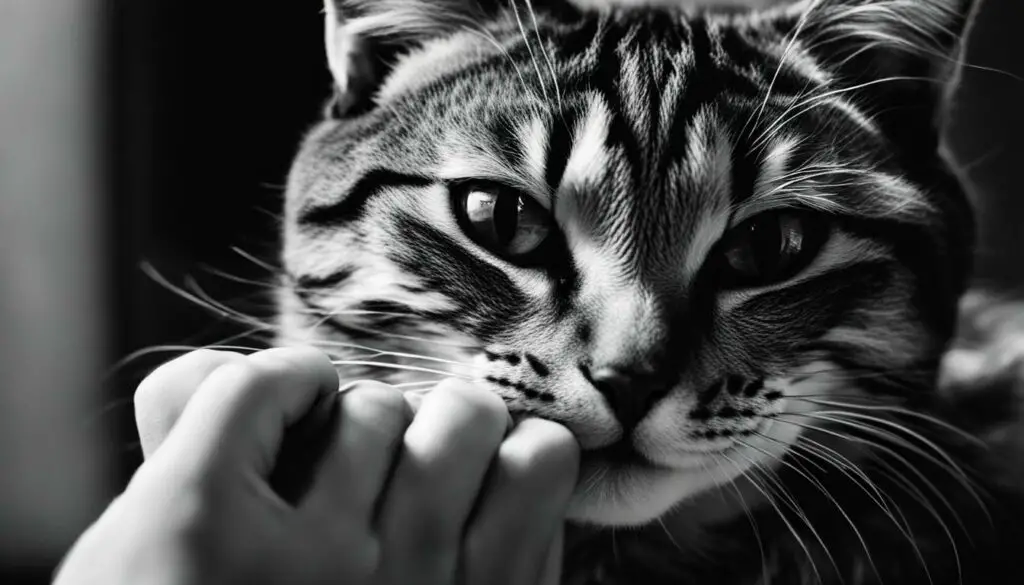
| Signs of Fear and Stress in Cats | Ways to Alleviate Fear and Stress |
|---|---|
|
|
|
|
|
|
“Understanding the source of your cat’s fear and stress is the first step in helping them overcome it. By creating a calm and secure environment, providing appropriate outlets for their energy, and building a bond based on trust, you can help alleviate fear and stress-related biting.”
Cat Biting and Territorial Behavior
When it comes to cat biting, understanding their territorial behavior is key. Cats are naturally territorial animals, and biting can be a way for them to mark their territory and assert dominance. This behavior may manifest as biting their owners’ noses during sleep, which can be seen as a display of their territorial instincts.
Providing appropriate outlets for territorial marking, such as scratching posts or designated areas, can help prevent biting. By allowing cats to engage in territorial marking in a controlled and accepted way, owners can help redirect their cats’ behaviors and foster a peaceful coexistence.
It’s important to note that territorial behavior in cats can vary. Some cats may be more prone to territorial aggression, while others may exhibit milder displays of dominance. It’s essential for cat owners to observe their cats’ body language, recognize signs of territoriality, and respond accordingly to ensure a harmonious environment for both the cat and the owner.
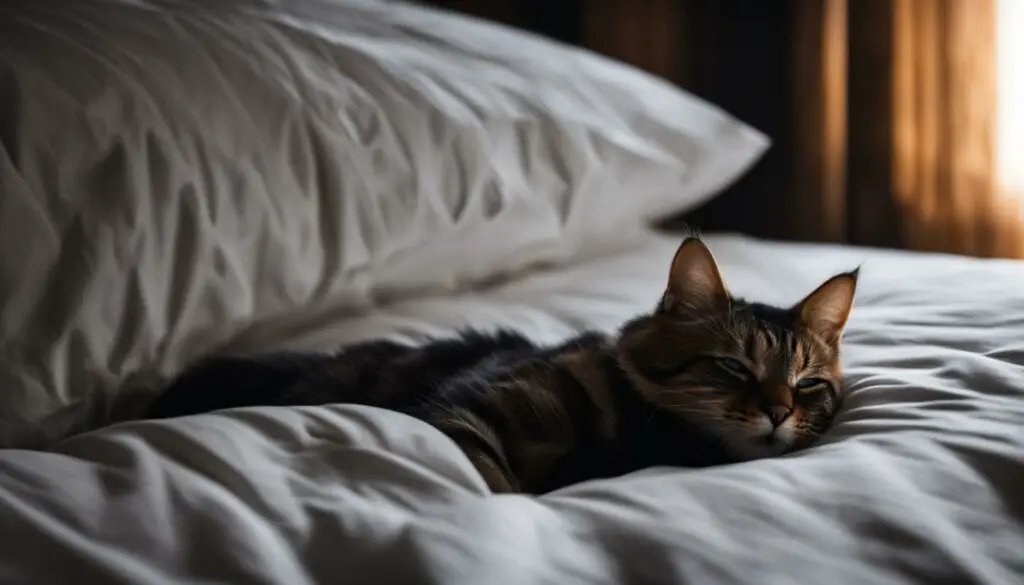
Understanding Cat Body Language
When it comes to addressing territorial behavior, understanding cat body language can be immensely helpful. Cats use various cues to communicate their emotions and intentions. By paying attention to ear position, tail movement, and overall posture, owners can gain insights into their cat’s territorial mindset.
For example, a puffed-up tail, ears pointed backward, and an aggressive posture can indicate that a cat is feeling threatened and may resort to biting. Conversely, a relaxed body posture, ears facing forward, and a gently swaying tail can signal a more content and non-aggressive territorial state.
By interpreting their body language correctly, owners can anticipate and address potential territorial conflicts, creating a more peaceful and stress-free environment for their cats.
Significance of Cat Body Language
Understanding cat body language is essential for deciphering their behaviors, including biting. Cats communicate through a variety of visual cues, and being attuned to their body language can help interpret their emotions and intentions. By observing their ear position, tail movement, and overall posture, we can gain valuable insights into a cat’s mood and prevent potential biting episodes.
Cat body language can vary based on the individual cat and the situation at hand. For example, a cat with their ears forward and tail held high may be feeling confident and relaxed. On the other hand, flattened ears and a tucked tail could indicate fear or aggression. Recognizing these signals allows us to respond appropriately and create a safe environment for our feline companions.
It’s important to note that while cats may bite during sleep, this behavior is not always aggressive. By understanding their body language, we can differentiate between playful biting and aggressive behavior. Playful biting is typically accompanied by a relaxed posture, soft ears, and a flicking tail, while aggression is characterized by a tense body, dilated pupils, and an arched back. This distinction helps us respond appropriately and avoid any potential harm.
Understanding Cat Tail Language
The position and movement of a cat’s tail can convey valuable information about their mood and intentions. A cat with an upright tail often indicates a friendly and confident disposition, while a puffed-up tail suggests fear or aggression. A gently swaying tail is a sign of relaxation, while a twitching tail can indicate excitement or annoyance. By paying attention to their tail language, we can better understand and respond to our cats’ needs.
| Tail Position | Meaning |
|---|---|
| Upright, slightly curved | Confidence, friendliness |
| Puffed up | Fear, aggression |
| Gently swaying | Relaxation |
| Twitching | Excitement, annoyance |
By understanding and respecting cat body language, we can strengthen our bond with our feline companions and ensure their well-being. Creating a safe and comfortable environment and responding appropriately to their needs and signals can help prevent biting behaviors and foster a harmonious relationship between cat and owner.
Eye Contact and Biting
When it comes to cat behavior, eye contact plays a significant role in their interactions with humans. Cats may hold eye contact with their owners as a sign of respect, trust, or curiosity. This can foster a sense of connection and strengthen the bond between cat and human. However, it’s important to note that prolonged direct staring can be perceived as a threat by cats, leading to defensive behaviors such as biting.
By understanding the nuances of eye contact, cat owners can navigate their feline companions’ behaviors more effectively. Maintaining a soft gaze and avoiding intense, prolonged eye contact can help create a positive and comfortable environment for both the cat and its owner. When a cat feels safe and secure, the likelihood of biting or other defensive behaviors decreases.
“Cats use eye contact to communicate their feelings and intentions. While some cats may hold eye contact to convey trust and affection, others may interpret it as a challenge or threat. It’s essential to read your cat’s body language and respond accordingly.”
Being mindful of your cat’s body language is crucial when engaging in eye contact. Pay attention to their ear position, tail movement, and overall posture to gauge their mood and comfort level. If your cat shows signs of anxiety or discomfort, it’s best to break eye contact and give them space. Communication with cats is a delicate dance, and respecting their boundaries is key to maintaining a harmonious relationship.
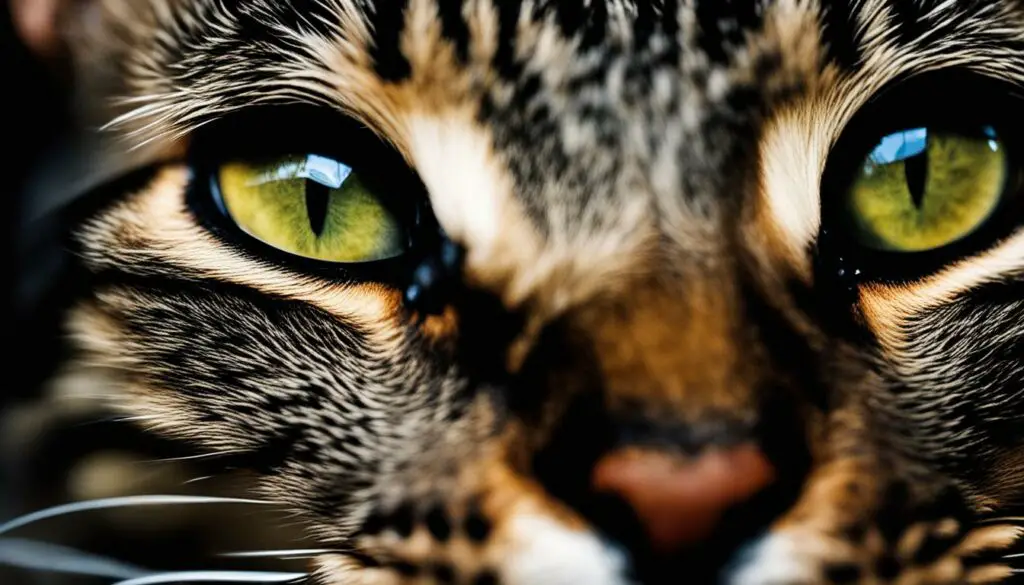
The Role of Meowing
Meowing is a common way for cats to communicate with their owners. It serves as a means for cats to express their needs, desires, and emotions. As a cat owner, deciphering the context and tone of your cat’s meows can provide valuable insights into what they are trying to convey. Here are some common reasons why cats meow:
- Attention: Cats may meow to get your attention or seek interaction. They may want to play, be petted, or simply be in your presence.
- Hunger: Cats often use meowing as a way to communicate that they are hungry and want to be fed. This meow may be accompanied by other behaviors, such as rubbing against your legs or leading you to their food bowl.
- Discomfort: If your cat is feeling uncomfortable or in pain, they may meow to alert you. It could be a sign of illness, injury, or distress. Pay attention to any changes in behavior or meowing patterns that could indicate an underlying issue.
- Stress or anxiety: Cats may meow more frequently when they are feeling stressed or anxious. Changes in their environment, such as moving homes or the presence of new pets, can trigger this meowing behavior. Providing a safe and calm environment, along with plenty of enrichment and attention, can help alleviate their stress.
It’s important to note that the meaning behind a cat’s meow can vary depending on the individual cat and the situation. By closely observing their behavior and taking note of any patterns or cues, you can better understand and respond to your cat’s needs.
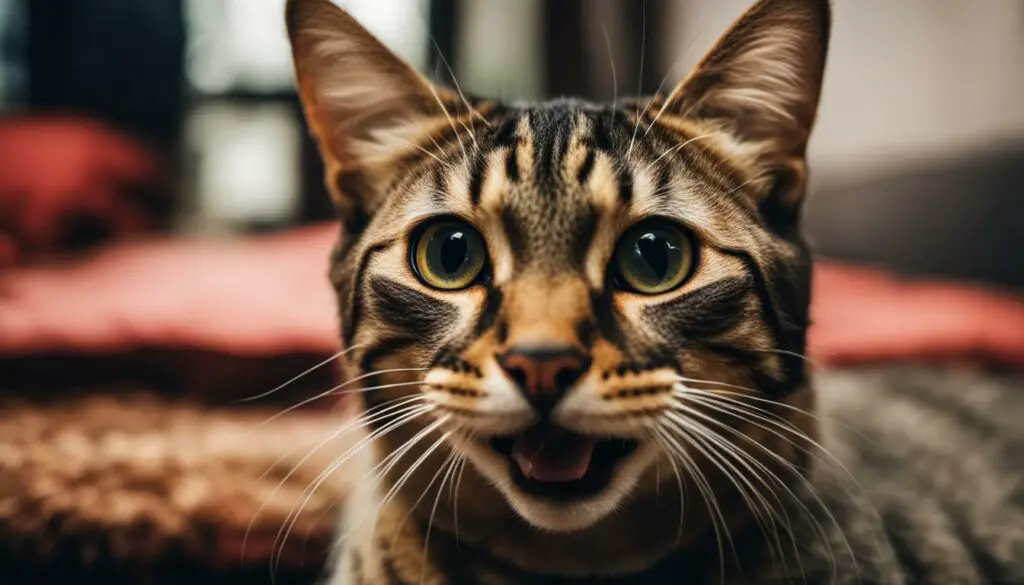
Sneezing and its Meaning
Cats may sneeze for various reasons, including dust particles or allergies. However, persistent or excessive sneezing can indicate underlying respiratory infections or allergies. Sneezing is a natural reflex that helps cats clear their nasal passages of irritants. It is important to pay attention to the frequency and duration of sneezing episodes, as well as the presence of any other symptoms such as nasal discharge or wheezing, to determine the cause of the sneezing.
Sneezing can also be a sign of a viral or bacterial infection, such as the feline herpesvirus or feline calicivirus. If your cat is experiencing frequent sneezing along with other symptoms like coughing, runny nose, or fever, it is recommended to consult a veterinarian for a proper diagnosis and treatment.
If your cat is sneezing occasionally without any other concerning symptoms, it is likely a harmless reaction to an environmental irritant. However, if the sneezing becomes persistent or is accompanied by other signs of illness, it is best to seek professional veterinary advice to ensure the health and well-being of your cat.
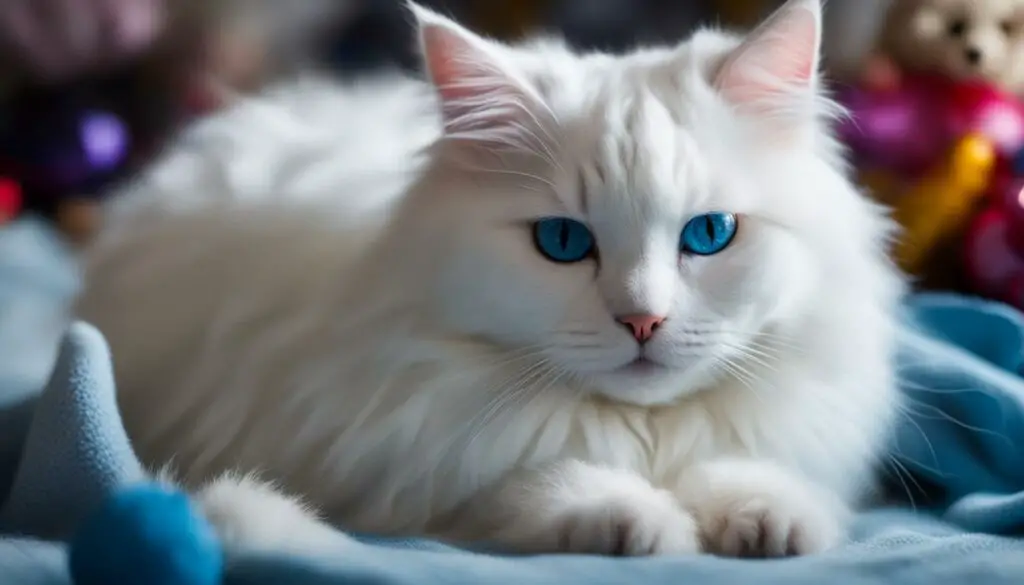
Common Causes of Sneezing in Cats:
- Dust particles or irritants in the environment
- Allergies
- Respiratory infections
- Viral or bacterial infections
| Cause | Symptoms |
|---|---|
| Dust particles or irritants | Occasional sneezing, no other symptoms |
| Allergies | Sneezing, itching, watery eyes, skin irritations |
| Respiratory infections | Frequent sneezing, coughing, runny nose, fever |
| Viral or bacterial infections | Sneezing, nasal discharge, coughing, lethargy |
It is important to observe your cat’s behavior, monitor their overall health, and seek veterinary advice when necessary. Cats are prone to respiratory issues, and early intervention can prevent complications and ensure a prompt recovery.
Sleeping with Cats
Sharing your bed with a furry feline companion can be a delightful experience for both you and your cat. Sleeping with cats is a common behavior that stems from their instinctual need for comfort, security, and a strong bond with their humans. Cats may choose to sleep with their owners as a way to show affection, trust, and a sense of belonging.
When your cat curls up next to you at night, it’s a sign that they feel safe and comfortable in your presence. The warmth and rhythm of your breathing can provide a soothing environment for your cat, promoting relaxation and a sense of security. This close proximity during sleep can help strengthen the bond between you and your feline friend.
While sleeping with cats can be a rewarding experience, it’s important to keep in mind a few considerations. Some cats may be more active during the night, which could disrupt your sleep. Providing your cat with plenty of playtime and engaging toys before bedtime can help tire them out and promote a more peaceful night’s sleep.
Additionally, it’s important to maintain good sleep hygiene for both you and your cat. This includes keeping your bedroom clean, well-ventilated, and free from allergens that could affect your cat’s respiratory health. Regular veterinary check-ups can help ensure that your feline companion is in good health and ready for a restful night’s sleep.
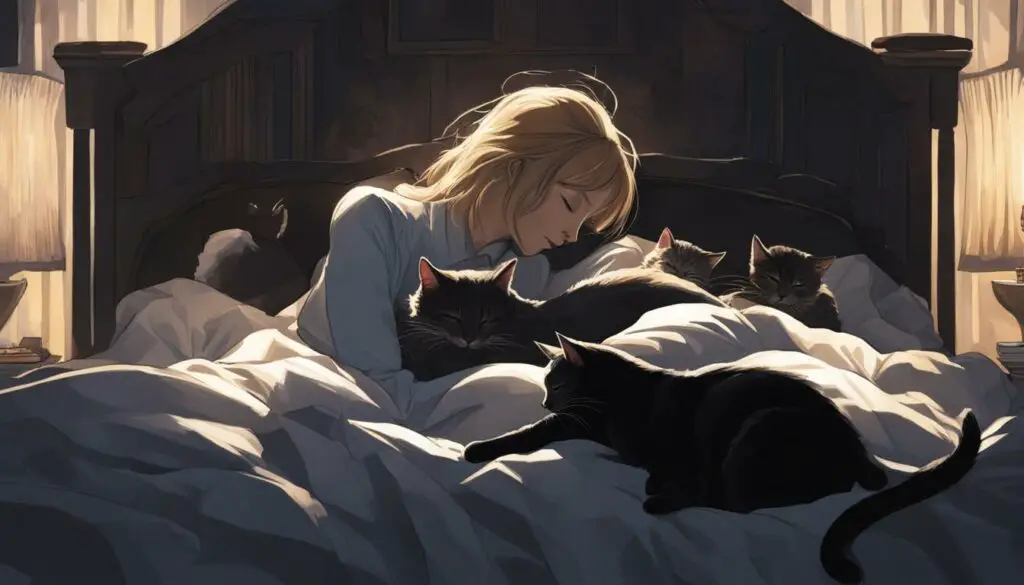
Benefits of Sleeping with Cats
- Enhances the bond between you and your cat
- Provides comfort and security for your cat
- Promotes relaxation and reduces stress for both you and your cat
- May help alleviate anxiety or separation issues in some cats
- Creates a warm and cozy sleeping environment
Remember, each cat is unique, and their preferences for sleeping arrangements may vary. Some cats may prefer to sleep beside you, while others may choose to sleep at the foot of the bed or in their own designated sleeping area. Pay attention to your cat’s cues and respect their boundaries.
Sleeping with cats can be a wonderful way to strengthen your bond and enjoy the company of your feline friend. So go ahead, snuggle up, and have a purr-fectly restful night’s sleep with your beloved cat.
Following Behavior and Its Meaning
One fascinating aspect of cat behavior is their tendency to follow their owners from room to room. This following behavior is often seen as a sign of their deep bond and desire for companionship. Cats are naturally social creatures, and their instincts drive them to seek close proximity with their human caregivers.
This behavior can manifest in various ways, such as a cat trailing closely behind their owner or even leading the way. It is their way of expressing affection, trust, and a desire for attention. When a cat follows their owner, it creates a sense of companionship and reinforces the cat-human bond.
“Having my cat follow me around the house makes me feel loved and needed. It’s as if she can’t bear to be apart from me. I cherish these moments of connection.” – Cat owner
Understanding the Meaning
While following behavior is often seen as a positive sign, it’s essential to understand the underlying motivations behind it. Cats may follow their owners to seek security, as they perceive their humans as a source of safety and comfort. Additionally, it may be their way of ensuring they don’t miss out on any potential attention or opportunities for play that may arise.
To facilitate a healthy and happy cat-human bond, it’s crucial to respond positively to your cat’s following behavior. Take time to engage with your cat, offering affection, playtime, or simply acknowledging their presence. This will reinforce their sense of belonging and strengthen the bond you share.
So, the next time your cat faithfully follows you from room to room, embrace the moment and enjoy the unique connection you have with your feline companion.
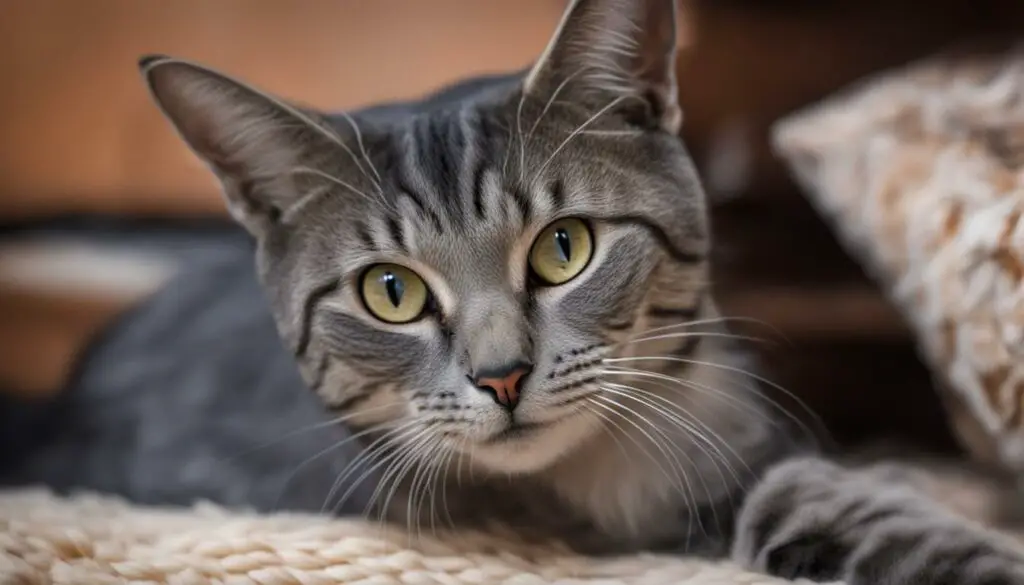
Conclusion
Understanding cat behavior is crucial for fostering a strong and harmonious bond between cats and their human companions. From decoding their biting behavior during sleep to interpreting their body language, it is essential to recognize their needs and provide a safe and comfortable environment.
By observing a cat’s body language, such as ear position, tail movement, and overall posture, we can gain insights into their mood and intentions. This allows us to respond appropriately and prevent biting episodes.
Building a strong cat-human bond involves positive reinforcement and understanding their unique communication methods. By recognizing that cats bite for various reasons, such as communication, play, overstimulation, fear, or stress, we can respond in a way that strengthens our bond with these curious and independent creatures.
So, next time your cat nibbles on your nose while you’re sleeping, remember to decode their behavior, provide them with the attention and environment they need, and enjoy the special connection that comes with sharing your life with a feline companion.
FAQ
Why does my cat bite my nose when I’m sleeping?
Cats may bite during sleep for various reasons, such as communication, play, overstimulation, fear, or stress. Understanding the motivations behind this behavior can help cat owners respond appropriately and strengthen their bond with their furry friends.
Why do cats bite their owners’ noses during sleep as a form of communication?
This behavior is not typically motivated by anger or spite but rather serves as a way for cats to express their needs or desires. By biting, cats are attempting to get the attention of their owners and convey a message.
Why do cats bite their owners’ noses during sleep as a form of play behavior?
Just like how they may bite during playtime while awake, cats may engage in similar behavior while their owners are sleeping. This biting is usually not aggressive and is a way for cats to engage in interactive play.
Why do cats bite their owners’ noses during sleep when they are overstimulated?
Cats can become overstimulated during petting sessions, leading to biting as a way to communicate that they have had enough. This behavior, known as petting aggression, is an instinctual response and should be respected.
Why do cats bite their owners’ noses during sleep when they are feeling fearful or stressed?
Changes in the environment, such as moving homes, can trigger these emotions in cats, leading to defensive or fearful behaviors. Understanding the source of stress and providing a safe and calming environment can help alleviate biting behavior.
Why do cats bite their owners’ noses during sleep as a display of territorial behavior?
Biting their owners’ noses during sleep can be a display of territorial behavior. Providing appropriate outlets for territorial marking, such as scratching posts or designated areas, can help prevent biting.
Why is understanding cat body language crucial for interpreting biting behavior?
Cats use various body language cues to express their emotions and intentions. Paying attention to ear position, tail movement, and overall posture can provide insights into a cat’s mood and help prevent biting episodes.
What does eye contact with a cat mean in terms of biting behavior?
Cats may hold eye contact with their owners as a sign of respect, trust, or curiosity. However, prolonged direct staring can also be seen as a threat and may provoke defensive behaviors, including biting.
What is the significance of meowing in cat communication?
Cats may meow to seek attention, ask for food or water, or express their needs. Understanding the context and tone of the meow can help decipher the message that the cat is trying to convey.
Why do cats sneeze, and when should I be concerned?
Cats may sneeze for various reasons, including dust particles or allergies. However, persistent or excessive sneezing can indicate underlying respiratory infections or allergies. Observing patterns and seeking veterinary advice can help determine the cause of frequent sneezing in cats.
Why do cats choose to sleep with their owners?
Sleeping with cats is a common behavior that stems from their instinctual need for comfort, security, and bonding. Cats may choose to sleep with their owners as a way to show affection, trust, and a sense of belonging.
Why do cats follow their owners from room to room?
Cats may exhibit following behavior as a way to show their desire for companionship and to be close to their owners. Cats are social creatures, and their need for social interaction can lead them to follow their owners from room to room.
Source Links
- https://www.pumpkin.care/blog/why-does-my-cat/
- https://www.dailypaws.com/cats-kittens/cat-behavior/decoding-cat-language
- https://www.goodpetparent.com/2014/10/18/why-does-my-cat-do-that/

